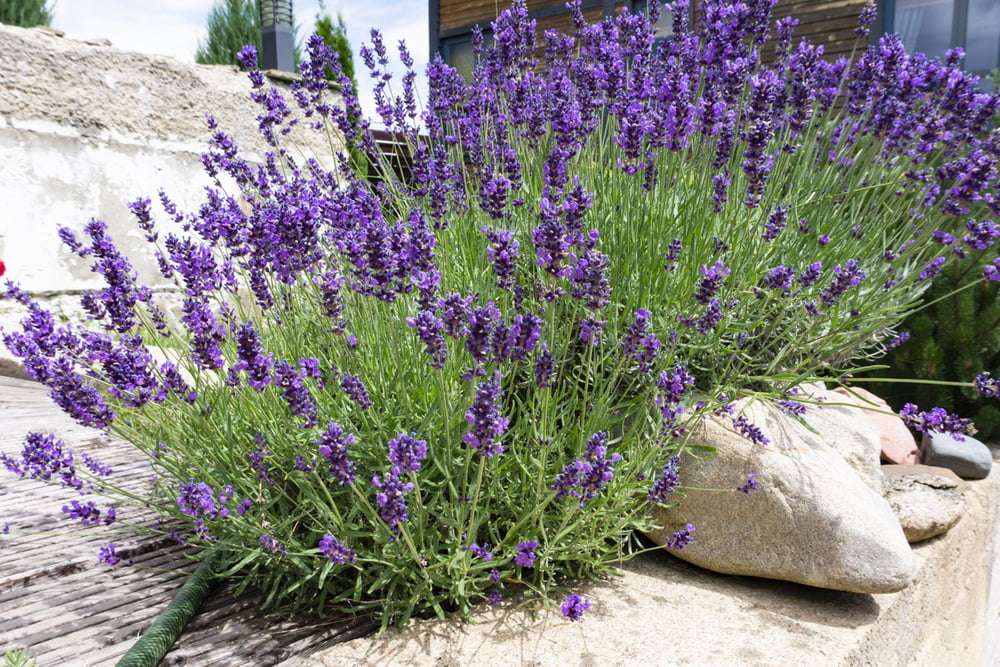Lavender captivates not only with its great color, but also with its aromatic smell. Here you can read how to grow and propagate lavender.
Lavender belongs to the labiates family and occurs in about 30 genera and subgenera. Typically, the shrub is purple, but there are also varieties in white, pink and blue. It is very suitable for seasoning dishes and for making your own essential oils and room fragrances. The flowers are also good as a natural moth repellent in the closet.
Content
- The right location for lavender
- How to care for lavender
- Cutting lavender
- Harvesting and using lavender
- Propagating lavender
- Overwintering lavender
Lavender is easy to grow and propagate, both in the garden and on the balcony.
Contents
Growing lavender: Location
Lavender prefers a sunny and dry location. Conversely, this also means that waterlogging should be avoided at all costs. Also too high humidity is not good for lavender. Furthermore, the plant is sensitive to strong wind and should therefore be placed in a wind-protected location.
Lavender care
To properly care for lavender, you should pay attention to the following points:
In terms of soil conditions, lavender is very frugal. The main thing is that the soil is permeable to water. On sale, lavender is even often offered in a soil-sand-lime mixture.
Lavender also does not require much in the way of nutrients. On the contrary, too many nutrients in the soil will harm the plant.
Be careful not to plant the lavender plant outdoors too early. Lavender is sensitive to frost.
Be sure to save on fertilizer. If anything, lavender should be fed with low-nitrogen fertilizer. Too much fertilizer will make it more susceptible to frost.
Prune lavender
Well cared for, the lavender bush grows vigorously. Therefore, it is important to prune the lavender: At least once, better even twice a year, you should prune your lavender. The first pruning you do – as with many other plants – ideally just before the plant sprouts, that is, in the spring. The second pruning is done in late summer after flowering.
Harvest lavender
Many have lavender in the garden or on the balcony simply as a beautiful and fragrant plant. However, you can also harvest your lavender. Here’s how:
Harvest lavender just before it blooms. At this time, the aroma is most intense.
The ideal time to harvest is in the late morning, when dew drops and the like are no longer visible. Choose a day that is as warm as possible and, above all, sunny.
Don’t just cut off the flower heads. Make sure you cut off a sufficient stem of about ten centimeters as well.
The stems are perfect for hanging the lavender to dry. To do this, bundle the cutting into small bunches and hang them in a dry and shady place.
Lavender in the kitchen
In this country, lavender is not yet widely used in the kitchen, yet the aromatic plant can give a very special touch to a variety of dishes.
Note: Not all lavender varieties are edible. Lavendula stoechas or Lavendula latufolia are not suitable for consumption. Edible is among others the so-called true lavender (Lavendula angustifolia)
Depending on the genus and variety, lavender tastes sweetish to slightly bitter. Dried lavender tastes more intense than fresh.
You can use lavender as a seasoning for meat dishes. In addition, lavender is delicious as a tea, addition in sugar or as vinegar.
Lavender as a medicinal herb
The effect of lavender as a medicinal plant has been known for centuries and is used in many ways. Lavender oil and tea, for example, are excellent against nervousness and restlessness and can even help you fall asleep. Lavender oil is also good for rubbing on sunburn, rheumatism or even colds.
Overwintering lavender
Lavender is sensitive to frost. Many varieties are declared as “winter-hardy”, but they are only conditionally so. Lavender does not die immediately at the slightest bit of frost, but if the temperatures slip below freezing for a longer period of time, it becomes critical. Therefore, you should pay attention to the following things to properly overwinter your lavender:
If you have grown your lavender in a pot, it is best to bring it indoors during the colder months. If that is not possible, you can place cold insulating materials such as Styrofoam under the pot. You should also wrap the pot with bubble wrap or jute fabric and place the lavender bush close to the wall of the house.
Lavender bushes planted outdoors can cover them with plant frost protection mats made of fleece, coconut and co. from stores or fir brushwood. In addition, you should spread a layer of mulch directly on the soil below the shrub.
Propagate lavender
Once you get a taste for lavender, you may soon want more. A single shrub may almost be too little then. Instead of buying a new plant, you can simply propagate your lavender. The easiest way to do this is with cuttings:
Use the clippings they removed during spring pruning.
So when pruning, make sure to cut off pieces that are at least 15 inches long.
Remove the lower leaves from the stem and then plant the seedlings about 10 centimeters deep in nutrient-poor soil.
The soil should always be kept moist. Avoid waterlogging at all costs.
Once the first roots have formed after a few weeks, you can transplant the small plants individually into pots.
You can grow lavender cuttings all year round. However, the young plants should not be planted outdoors until mid-May. If you plant the cuttings in autumn, you should overwinter them indoors if necessary, or at least protect them from frost in the open and cover them well.
Whether used as a garden or balcony decoration or for eating and as a medicinal plant, lavender is a versatile and easy-to-handle plant that can bring you many years of enjoyment. With our tips, you can bring a touch of vacation to your home.


